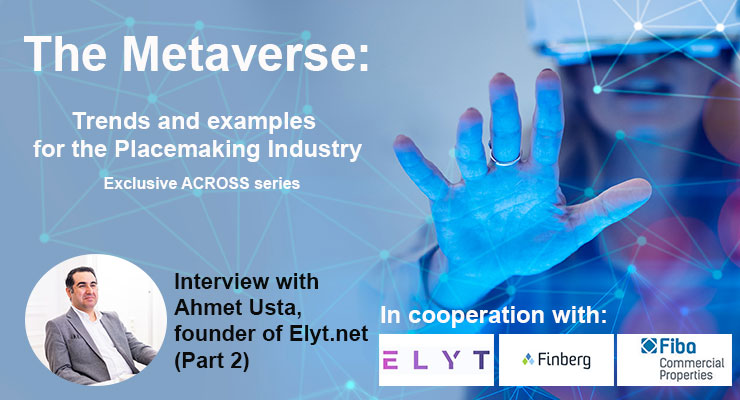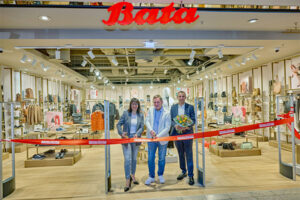ACROSS: Almost two decades ago, “Second Life,” an attempt to create a digital parallel world, failed big time. What is different about the Metaverse?
Usta: Although Second Life was unable to sustain its success, it was very successful in its time and even established an economic freedom area where millions of people could earn serious incomes in this world. However, developer mistakes, changing interests of the community, and new platforms made Second Life’s collapse inevitable. Millions of avatars and the digital assets they owned disappeared into thin air. If it were a real Metaverse application, it would have been possible to move them to different universes.
ACROSS: Is there one Metaverse, or could there be several?
Usta: We can certainly talk about multiple universes. Today, collaborations are needed to switch between different Metaverse platforms, but in the future, with the development of open data standards, collaborations will not be necessary. Switching freely between different Metaverse platforms will become possible.
ACROSS: Even big tech giants like Meta had to fire 11,000 people at the beginning of the year. What is the problem at the moment in terms of development? How well advanced are we in development at the moment, and how long is it likely to be before the niche phenomenon becomes mass adoption?
Usta: Meta is canceling projects and making large layoffs because their vision is not to create a real Metaverse, as we have been trying to explain. This process is not as easy as changing a name. The virtual world they are trying to build is a massive prison, with the goal of seizing people’s time and labor and commercializing it. They have been doing this for many years already. They cannot reap the rewards of their efforts to build this universe because we still need time for the technologies to catch up to the three-dimensional worlds they show people. Videos of wearing glasses and playing basketball with your friends or accompanying a friend climbing Mount Everest are just a fantasy. They have nothing to do with reality now.
Mass adoption of the Metaverse will not be in the form of 3D environments or the way Meta is trying to achieve it in the short to medium term. If we define the Metaverse as the absolute domination and free disposal of digital assets, it would be a mistake to reduce it to 3D environments.
Why can’t bank loans or insurance policies have their own Metaverse? Why can’t there be a shared Metaverse for all collaborative workspaces around the world? Why can’t different loyalty programs have their own Metaverse? Yes, you should now feel that the sun is beginning to rise; 3D worlds will be a part of my Metaverse, but the Metaverse is much more than that.
The Metaverse – A big need for knowledge
Without a doubt: The Metaverse is the megatrend of this year and the years to come. This became more than evident at the 2022 MAPIC meeting of the ACROSS Advisory Board. At the same time, hardly any other topic makes even the most experienced industry experts feel so insecure. NFTs, avatars, holograms, and blockchains – are all part of the Metaverse, a network of offline and virtual worlds and buzzwords in the industry. At the same time, the industry is just taking baby steps in their daily work to come up with metaverse solutions. What real solutions for the placemaking industry should look like and, even more so, how these are implemented has so far remained largely vague. Last but not least, the discussion in Cannes shows that the industry needs more knowledge about the mechanisms, opportunities, and examples of concrete applications. To achieve this, ACROSS has teamed up with Elyt.net, Finberg, and FİBA Commercial Properties to create an editorial series to provide first-hand content on how shopping places can benefit from the Metaverse. In the first part Ahmet Usta, the co-founder of Elyt.net, “translates” the metaverse for our industries.
ACROSS: What drives companies like Nike or Apple to invest millions in companies that are operating in the Metaverse?
Usta: It’s true that the internet entered our lives as a communication protocol, social media turned it into an interactive tool, and companies like Amazon turned it into a commerce platform. Cell phones were just communication tools, but Apple turned them into computers. Companies that didn’t catch up with these revolutions found themselves in meetings discussing how to compete with their massive competitors. Even worse, brands that couldn’t even do that have found their place in history books. A new concept is emerging for businesses, which may require a change in both mindset and business models. I believe these are the main motivations for large brands.
ACROSS: What do you think is the most promising way of application in the shopping center industry?
Usta: While shopping malls continue to sustain their physical presence, attempting to enter the Metaverse universe with a limited definition confined to 3D worlds will be a daring adventure. On the other hand, with the approach we described in the previous paragraphs, I believe that there could be new and exciting business models for both shopping malls and brands with stores in them. For example, deals can be made with gaming companies. This way, customers can have a digital copy of the products they buy from stores within the games.
Rather than building their own 3D world, shopping malls can participate in game studio projects and create experiences that offer opportunities to gamers. However, there is an area that can be approached faster than these, customer experience and marketing.
ACROSS: What is the big difference that Web 3.0 shopping centers can offer in terms of marketing and customer relationship?
Usta: With Web 3.0, the absolute ownership rights of digital assets now pass to users. The services we access and use with a username and password become accessible through a wallet. We owe thanks to blockchain technology for enabling this.
According to KPMG’s “The truth about customer loyalty” research, 96% of users believe customer loyalty programs could be better, 78% want real rewards rather than just incentives, and 75% say they will switch brands immediately if they find something better. These numbers indicate a trust problem between brands and customers. Web 3.0 can solve these problems because blockchain technology turns trust from a risk into a protocol. Customer relationships can no longer be the same. New-generation users value emotional connections, but this is not enough; they are aware that brands need to grow with them and provide more value. Likes, positive comments, and thank wishes are not enough. Brands need to think like financial institutions to some extent, and Web 3.0 makes this mandatory.
Customer relationships can no longer be the same as before. New-generation users attach importance to emotional connections, but this is not enough. They are aware that brands are growing with them, and they want to gain more value from this. Likes, positive comments, and thanks are not enough. You need to create value beyond the product for customers. Every brand must learn to think like a financial institution to some extent, and Web 3.0 makes this mandatory.
Marketing is opening new channels for itself. With advancements in Artificial Intelligence, these channels include things that were previously only ideas, such as non-human characters, virtual environments, and games. Every day, these approaches are finding more and more applications.
Every visit to the shopping center, every step you take, every store you enter, every meal you order, every movie you watch in the cinema, every token you use in the entertainment area, every purchase you make, and every social interaction you create should now be turned into an accumulation. These accumulations should be kept in Web 3.0 wallets that customers have absolute control over or on service providers that offer these services in a very simple way. Customers should be able to freely save on the value they create. As a simple example, 10,000 steps I took in a shopping center in Italy should be able to turn into free French fries in the food court of a shopping center in Istanbul. We have an infinite world of possibilities ahead of us.
ACROSS: And finally, the most important and perhaps critical question for investors, companies, and operators of shopping centers: how do you get started with the Metaverse?
Usta: The Metaverse is complex and can easily overwhelm even experienced decision-makers. Therefore, it is important to take a deep breath and realize that while technology is advancing and we may feel overwhelmed by new concepts, we are not facing an overnight threat that will destroy all industries. In this interview, we provided some basic definitions for innovative concepts such as Blockchain, NFT, Metaverse, and Web 3.0. We must accept that this will require a shift in thinking that will ultimately trigger a transformation in business models, but it is not something that can be done overnight. Successful examples are few and far between, and there are many technologies in history that have produced unexpected results or died during this process. We must also keep this in mind.
Despite what advertisements may suggest, no one has a magic wand. Motivation should not be based on FOMO (fear of missing out). It is important to read about these concepts from different perspectives. Then, taking small steps by creating PoCs (proof of concept) and testing them is the right choice. Joining media and community platforms that specialize in specific industries, like ACROSS Media, can be helpful in guiding this process. These types of platforms can showcase successful applications and inspire new ideas. Sharing knowledge to build a future based on sharing and ownership economy will always be the most effective strategy.
Learnings Part 2:
1. There are multiple Metaverses, but switching freely between different Metaverse platforms will be possible.
2. Through the Metaverse, customers can have two pieces of the same product: a physical one and a digital copy of the products they buy from stores within the games.
3. With Web 3.0, the absolute ownership rights of digital assets are now passed to users.

Ahmet Usta and Elyt.net
Ahmet Usta graduated with a bachelor’s degree in aerospace engineering from Istanbul Technical University in 2001 and earned his MBA from Yildiz Technical University in 2007. He has served as an IT Manager for various companies until 2014. During this time, he also served as the Technology Editor of Bloomberg Businessweek Turkey Magazine. Before founding Mercek Tech in 2017, Usta implemented technical and administrative projects to establish and manage digital and print media channels for different media companies. Then continue to deliver company journalism solutions with Mercek Tech. As a professional keynote speaker, lecturer, and advisor in Turkey, Usta specializes in Blockchain technology. He is a Co-Founder of ELYT.net, a next-generation Customer Loyalty and Marketing platform that utilizes blockchain technology and NFT assets. The vision of ELYT.net is to become a Metaverse Platform for Loyalty Programs.
More about the Metaverse:
ACROSS has teamed up with Elyt.net, Finberg, and FİBA Commercial Properties to provide first-hand content on how shopping places can benefit from the Metaverse. Stay tuned for articles on:
+ Second part of the interview with Ahmet Usta
+ Technological environment and investment opportunities
+ Business cases within the placemaking industry
+ The solution: Live session on a concrete product presentation in cooperation with Elyt.net and Fiba






